Calamite fragment with peculiar details
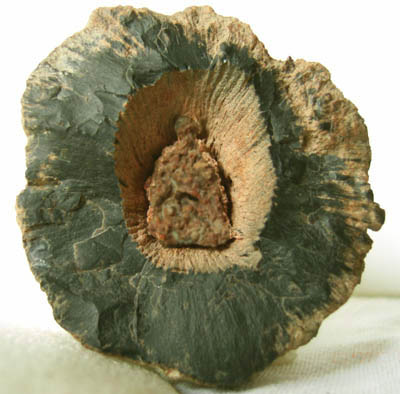 The
calamites of the Carboniferous and Permian
swamps and floodplains are ancient
relatives of the extant horsetails (Equisetum).
Except for
their big size, most of them resemble the
horsetails with their articulated habit of stem
and branches and their material-saving construction: strong
tubes, originally filled
with pith, later empty. The pith cavity extending along the wooden
members
becomes much narrower and eventually vanishes at the ends, which makes
sense since this strengthens the joint between the members.
The
silicified fragment presented here shows just such an end of the pith
cavity (Fig.1), however
with unexpected additions.
The
calamites of the Carboniferous and Permian
swamps and floodplains are ancient
relatives of the extant horsetails (Equisetum).
Except for
their big size, most of them resemble the
horsetails with their articulated habit of stem
and branches and their material-saving construction: strong
tubes, originally filled
with pith, later empty. The pith cavity extending along the wooden
members
becomes much narrower and eventually vanishes at the ends, which makes
sense since this strengthens the joint between the members.
The
silicified fragment presented here shows just such an end of the pith
cavity (Fig.1), however
with unexpected additions.
Fig.1: Fragment of a silicified calamite branch, Lower Permian,
Saar-Nahe Basin, Germany. Width 5.5cm.
The striations converging towards the end of the
cavity reflect the principal
structure of calamite wood [1],
with growth beginning as narrow wooden wedges, radially arranged with
primary pith rays in between, which eventually fuse into homogeneous
wood not much differing from conifer wood, depending on the calamite
species.
An
innermost layer of the wood of about 1mm or less, with the
characteristic feature of the calamites, the carinal canals, seems to
have decayed before silicification. The
striations are not clearly seen everywhere so that their number can
only be estimated as about 70.
What incidentally looks like a weathered statuette in a vault defies an
easy explanation. It is a hard conglomerate of
various components glued together by amber-coloured chalcedony. Unexpectedly,
it is related to the surrounding wood in intricate ways:
First,
it is partially undercut, with the gap seen here as dark shadows
probably indicating the lost inner wood layer. If so, it must have
become silicified earlier than the wood. This assumption is
substantiated by the presence of a few imprints complementary
to
the lost tips of the wood wedges (Fig.2) and by some remaining wood in
the depth of the gap. What remains unexplained is which kind of process
could cause the innermost wood to decay
so evenly that the
pith cavity wall looks as nicely striated as it does.
Second,
at least two details of the conglomerate are outgrowths of the wood
protruding into the cavity, as
indicated by irregularities of the striation pattern. The "head" is a
wooden knob around which the striations are curved as if they were
streamlines (Fig.3). The knob has got curved wood cells aligned
along its surface. There is another connection between the wood and
the conglomerate below right in
Fig.1, also with
deviations in the wall pattern. Concerning the meaning of such
structures in the pith cavity, no explanation is attempted here.
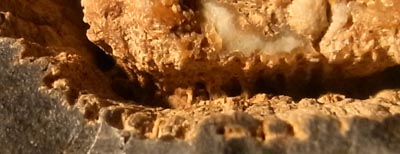

Fig.2: Lost calamite wood wedge tips preserved als imprints in the
chalcedony above.
Fig.3 (right): Calamite wood, irregularity in the striation pattern due
to
a wooden knob grown into the cavity.
There
is no bark left on the specimen, as usual. The wood is rather dense,
resembling coniferous wood in cross-section, tracheid diameters
30-40Ám. The secondary pith rays are numerous and narrow (Fig.4).
Slightly
broader pith rays tend to be there where in an
early growth stage the primary rays had
been.
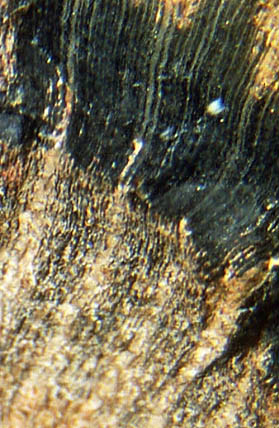
Fig.4: Calamite wood fracture face (above, dark) and wall
face of the empty pith cavity (below), textured according to the cellular structure.
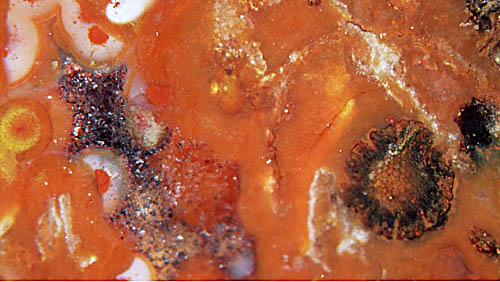 Fig.5:
Chalcedony fill of the cavity on the back
of the calamite
fragment, with root cross-section (right) and quartz
with black mineral deposit, probably hematite (left).
Fig.5:
Chalcedony fill of the cavity on the back
of the calamite
fragment, with root cross-section (right) and quartz
with black mineral deposit, probably hematite (left).
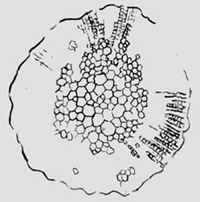
Fig.6: Cross-section of calamite root preserved in chalcedony,
width 1.2mm.
The depth of the
present fragment is only about 2cm. Within this distance the cavity
diameter reduces from about 2.5cm at the front of the fragment as seen
in Fig.1 to about
1cm on the back. There the cavity is filled with coloured chalcedony.
Enclosed is an object with well-preserved
tissue seen on
its circular cross-section (Figs.5,6). With large pith cells in the centre
surrounded by a wooden ring, its structure agrees with that of a tiny calamite root pictured in [2], named Astromyelon. One could
think up ways of how it got into the cavity: grown
there while the stem lay broken on the ground, washed into the
cavity together with the debris seen in Fig.1, or being another
unexpected outgrowth of the calamite wood. Perhaps the matter must
remain undecided.
Sample: Surprise find at a shallow pit dug on a field near Schallodenbach, Saar-Nahe basin, Germany, on the occasion of a
field trip guided
by H. Kerp in connection with the IOPC VIII conference,
Bonn 2008.
As an unexpected side effect, Fig.1 can be turned into an optical illusion, as demonstrated here.
H.-J.
Weiss 2012
[1] http://steurh.home.xs4all.nl/
[2] T.N. Taylor et
al.: Paleobotany. Elsevier 2009. Fig. 10.52.
|

|
 13 13 |

 13
13 The
calamites of the Carboniferous and Permian
swamps and floodplains are ancient
relatives of the extant horsetails (Equisetum).
Except for
their big size, most of them resemble the
horsetails with their articulated habit of stem
and branches and their material-saving construction: strong
tubes, originally filled
with pith, later empty. The pith cavity extending along the wooden
members
becomes much narrower and eventually vanishes at the ends, which makes
sense since this strengthens the joint between the members.
The
silicified fragment presented here shows just such an end of the pith
cavity (Fig.1), however
with unexpected additions.
The
calamites of the Carboniferous and Permian
swamps and floodplains are ancient
relatives of the extant horsetails (Equisetum).
Except for
their big size, most of them resemble the
horsetails with their articulated habit of stem
and branches and their material-saving construction: strong
tubes, originally filled
with pith, later empty. The pith cavity extending along the wooden
members
becomes much narrower and eventually vanishes at the ends, which makes
sense since this strengthens the joint between the members.
The
silicified fragment presented here shows just such an end of the pith
cavity (Fig.1), however
with unexpected additions. 


 Fig.5:
Chalcedony fill of the cavity on the back
of the calamite
fragment, with root cross-section (right) and quartz
with black mineral deposit, probably hematite (left).
Fig.5:
Chalcedony fill of the cavity on the back
of the calamite
fragment, with root cross-section (right) and quartz
with black mineral deposit, probably hematite (left).

 13
13